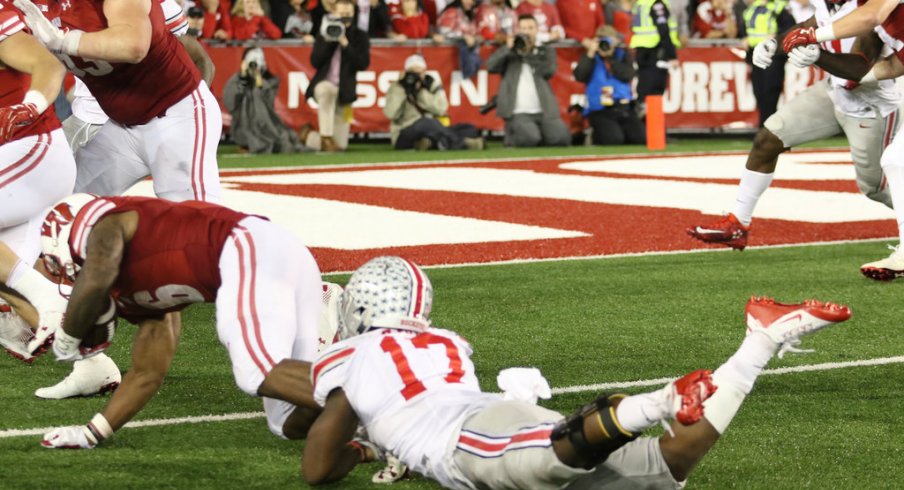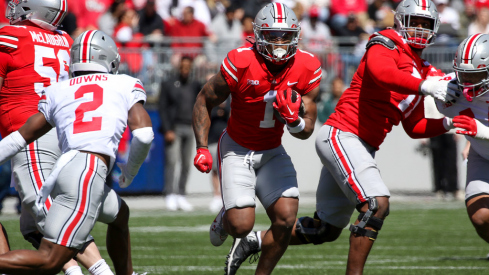Let's get this out of the way now: Paul Chryst is a very good coach.
Although he may not be regarded as an "Innovator" like many of the other great offensive minds in college football, favoring a traditional 'pro-style' system instead of a particular spread variation, Chryst still gets the absolute maximum from the talent at his disposal. While his methods may often seem boring to most fans, the way he finds success is often quite subtle, making small tweaks in formations or personnel needed to exploit a mismatch or capitalize on a specific tendency.
Conversely, nearly everyone that plays Ohio State knows what to expect from the Buckeyes. Urban Meyer's squad isn't afraid to show you what they want to run, knowing that the equation of talent plus execution almost always wins. In the first half of last Saturday's contest in Camp Randall stadium, however, Chryst's team seemed far better prepared for the task at hand.
The Wisconsin Badgers seemed to move the ball with ease during the first half, scoring on four of six first-half drives while holding the visiting Buckeyes to only a pair of field goals in the same span. As the two teams entered the locker room at the half, it was clear to anyone watching that Chryst's team had the better game plan coming into the matchup, the first such time that had happened to Meyer's squad all season.
So far during the 2016 campaign, the Buckeyes have consistently looked like the better team in every one of their games. With the exception of a few hiccups in the passing game a week prior against Indiana, the Ohio State coaching staff has had little work to do during halftimes this season. Down 16-6 in a hostile environment, though, Meyer's lieutenants had their work cut out for them.
Offensively, the Buckeyes had been stymied by the play of Wisconsin's excellent quartet of linebackers. Chryst's 3-4 look regularly gave the Buckeyes a seven-man box to run against, rendering inside carries ineffective. Additionally, the Badger secondary was quite aggressive, getting safeties D'Cota Dixon and Leo Musso up near the line to help in run support while daring J.T. Barrett and the Ohio State passing game to beat them deep.
Throughout the first half, this plan largely worked to perfection, as Meyer's squad only found success on outside runs with Curtis Samuel, allowing the electric runner to exploit his superior athleticism. But Samuel wasn't the only Buckeye explosive enough to beat the Badgers in space, and in the second half, they finally began to take advantage of that fact.
Instead of lining up with two backs in the backfield and a tight end, allowing all four Badger linebackers to line up close to the ball, the Buckeyes often lined up in four and five-receiver sets, spreading out Wisconsin's defense and opening up more passing lanes for Barrett underneath. As we can see in the example below, Samuel, Dontre Wilson, and Parris Campbell are all covered underneath by bigger, slower linebackers, giving the receivers a clear edge when trying to separate.
Not only did these spread formations allow the passing game to finally get on track, they allowed Barrett to find running lanes after dropping back to throw. The Badger pass rush relies heavily on blitzing linebackers, and with them now dropping into coverage, the Ohio State QB was able to pick up many of his 108 rushing yards on called pass plays.
On the other side of the ball, the Buckeye defense had to adjust for the first time since new coordinator Greg Schiano joined the staff, and the results were what you might expect from a former NFL head coach. Simple errors in execution like losing contain on the outside were cleaned up in the second half, taking away the big plays that had been constantly popping in the first.
But Schiano and co-coordinator Luke Fickell also countered many of the chess moves in Chryst's game plan, taking away many of the wrinkles called to manipulate the Buckeyes' man-to-man coverage in the secondary. One of the most successful in the first half was the Jet Sweep to wide receiver Jazz Peavy, who picked up nearly 70 yards on five first-half carries.
After Hooker began switching roles with the cornerback, streaking upfield to make the tackle, Chryst never called for the sweep again, opting instead to rely on an inside running game that was far less effective against the disruptive Buckeye defensive line. What had started as a game of strategy and scheme, with Chryst moving his pieces into the best positions possible, ironically turned into a battle of talent and execution.
While Meyer is known as an offensive "guru" and the Badgers are often labeled as a plodding, physical Big Ten stereotype, the reality of the overtime thriller in Madison saw those two roles reversed. Meyer and his staff did what was necessary to remove scheme from the equation as much as possible and lean instead on the gap in overall ability between the two teams.
"It's my job I guess to be upset and I was ready to tear into people, but I looked and saw a bunch of professionals," Meyer said after the game. "A defense who gave up 300 yards in the first half and someone said 33 or something in the third quarter."
The Buckeyes won because of numerous individual players out-dueling their opponents in one-on-one battle, both on the outside and in the trenches. And though that might seem at first as though they were 'out-coached' in that regard, the opposite is true.
Good coaches find ways to put their players in the best position to succeed, and then trust them to execute once there. By the time Meyer got his players to that spot late Saturday night in Wisconsin, he and his coaches had done their part.



